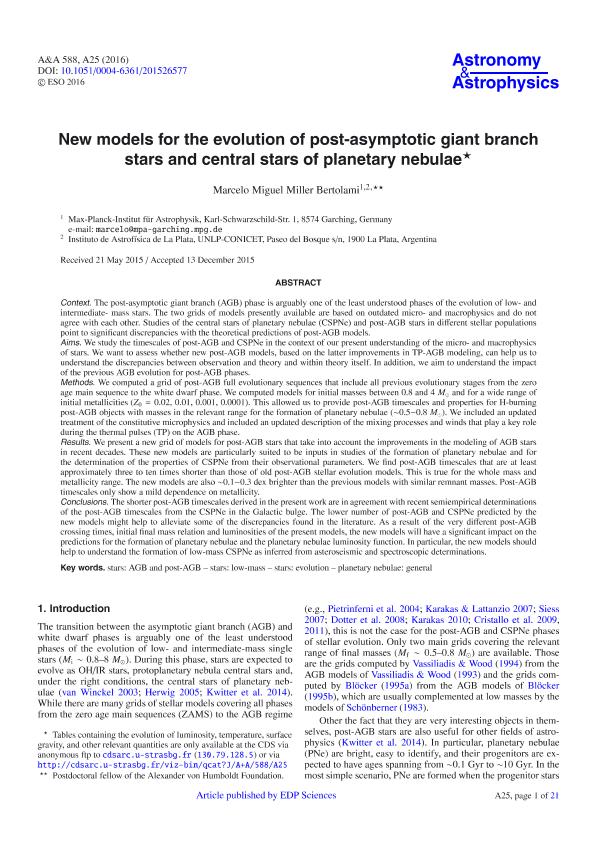Artículo
New models for the evolution of post-asymptotic giant branch stars and central stars of planetary nebulae
Fecha de publicación:
03/2016
Editorial:
EDP Sciences
Revista:
Astronomy and Astrophysics
ISSN:
0004-6361
Idioma:
Inglés
Tipo de recurso:
Artículo publicado
Clasificación temática:
Resumen
Context. The post-asymptotic giant branch (AGB) phase is arguably one of the least understood phases of the evolution of low- and intermediate- mass stars. The two grids of models presently available are based on outdated micro- and macrophysics and do not agree with each other. Studies of the central stars of planetary nebulae (CSPNe) and post-AGB stars in different stellar populations point to significant discrepancies with the theoretical predictions of post-AGB models. Aims. We study the timescales of post-AGB and CSPNe in the context of our present understanding of the micro- and macrophysics of stars. We want to assess whether new post-AGB models, based on the latter improvements in TP-AGB modeling, can help us to understand the discrepancies between observation and theory and within theory itself. In addition, we aim to understand the impact of the previous AGB evolution for post-AGB phases. Methods. We computed a grid of post-AGB full evolutionary sequences that include all previous evolutionary stages from the zero age main sequence to the white dwarf phase. We computed models for initial masses between 0.8 and 4 M and for a wide range of initial metallicities (Z0 = 0.02, 0.01, 0.001, 0.0001). This allowed us to provide post-AGB timescales and properties for H-burning post-AGB objects with masses in the relevant range for the formation of planetary nebulae (∼0.5−0.8 M). We included an updated treatment of the constitutive microphysics and included an updated description of the mixing processes and winds that play a key role during the thermal pulses (TP) on the AGB phase. Results. We present a new grid of models for post-AGB stars that take into account the improvements in the modeling of AGB stars in recent decades. These new models are particularly suited to be inputs in studies of the formation of planetary nebulae and for the determination of the properties of CSPNe from their observational parameters. We find post-AGB timescales that are at least approximately three to ten times shorter than those of old post-AGB stellar evolution models. This is true for the whole mass and metallicity range. The new models are also ∼0.1−0.3 dex brighter than the previous models with similar remnant masses. Post-AGB timescales only show a mild dependence on metallicity. Conclusions. The shorter post-AGB timescales derived in the present work are in agreement with recent semiempirical determinations of the post-AGB timescales from the CSPNe in the Galactic bulge. The lower number of post-AGB and CSPNe predicted by the new models might help to alleviate some of the discrepancies found in the literature. As a result of the very different post-AGB crossing times, initial final mass relation and luminosities of the present models, the new models will have a significant impact on the predictions for the formation of planetary nebulae and the planetary nebulae luminosity function. In particular, the new models should help to understand the formation of low-mass CSPNe as inferred from asteroseismic and spectroscopic determinations.
Palabras clave:
Agb Stars
,
Low Mass Stars
,
Evolution of Stars
,
Planetary Nebulae
,
Post-Agb Stars
Archivos asociados
Licencia
Identificadores
Colecciones
Articulos(IALP)
Articulos de INST.DE ASTROFISICA LA PLATA
Articulos de INST.DE ASTROFISICA LA PLATA
Citación
Miller Bertolami, Marcelo Miguel; New models for the evolution of post-asymptotic giant branch stars and central stars of planetary nebulae; EDP Sciences; Astronomy and Astrophysics; 588; 3-2016; 1-21
Compartir
Altmétricas




